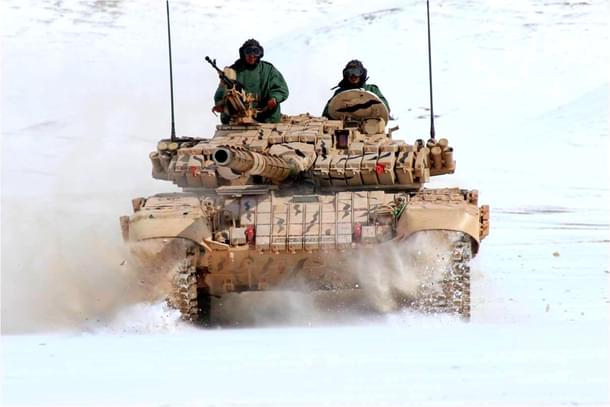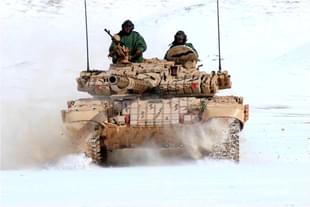News Brief
Chinese Twitter Bots, Global Times Must See These Videos From Ladakh; Here’s What A Real High-Altitude Military Exercise Looks Like
Swarajya Staff
Jun 08, 2020, 12:47 PM | Updated 01:33 PM IST
Save & read from anywhere!
Bookmark stories for easy access on any device or the Swarajya app.


Facebook and Twitter are forbidden in mainland China, but that hasn’t stopped bots of the Chinese Communist Party (CCP) from putting out videos of the People’s Liberation Army (PLA) ‘exercising’ in high-altitude areas, transporting shiny tanks and armoured personnel carriers (APCs), and moving troops to Tibet.
These bots, part of the Chinese disinformation machinery which runs a massive spambot network to amplify pro-Beijing messages on Twitter and Facebook, have been put into service amid a stand-off with India in eastern Ladakh.
Intended to target opinion overseas, rather than at home, the China’s disinformation machinery seems to have a large budget and decent resources at its disposal — the videos of choreographed military sequences put out by it have better production value than such sequences in Bollywood movies, some Twitter users said sarcastically.
And as if this wasn’t enough, the Global Times, an overt propaganda tool of the CCP, has also put out videos of PLA forces moving to Tibet from eastern China.
Several thousand soldiers with a Chinese PLA Air Force airborne brigade took just a few hours to maneuver from Central Chinaâs Hubei Province to northwestern, high-altitude region amid China-India border tensions. https://t.co/dRuaTAMIt0 pic.twitter.com/CtRJRk13IO
— Global Times (@globaltimesnews) June 7, 2020
‘What can be more believable than APCs moving in perfect lines, men with guns on their shoulders loading boxes on to trucks, and soldiers wearing helmets and sitting perfectly equidistant from each other for their journey to Tibet on a civilian aircraft,’ a Twitter user said in a sarcastic response to the video.
Some others pointed out that the Global Times and the CCP Twitter bots must see videos of India’s recent military exercise held in eastern Ladakh to understand the difference between a real exercise and outlandish propaganda.
In the second week of September 2019, Indian and Chinese troops were engaged in a stand-off at the Pangong Lake, which is also the site of the current stand-off.
Just days later, and a few weeks ahead of Chinese President Xi Jinping’s visit, India conducted a large-scale military exercise in the region, close to the Line of Actual Control (LAC).
This was the first time such an exercise was conducted in the region.
The rare integrated exercise in Eastern Ladakh saw the Indian military use all its big guns, from the US-built C-130 J transport aircraft to the Israel-supplied Heron unmanned aerial vehicle and Russian-origin Mi-17 V5 helicopters.
The exercise involved paratroopers being dropped from helicopters of the Army and supplies being dropped from C-130Js of the Indian Air Force.
This one seems to be a C 130J dropping supplies at night in Eastern Ladakh.
— Manu Pubby (@manupubby) September 18, 2019
(Close to the Chinese border) pic.twitter.com/y66dwD2YGj
The most striking, though, were the videos of tanks of the Indian Army kicking up dust and breathing out smoke as they moved up into firing positions.
Hunter pack of T 90s making their way up into firing position in East Ladakh, close to the Line of Actual Control. pic.twitter.com/SXEKJ2Jzvz
— Manu Pubby (@manupubby) September 18, 2019
Tanks involved in the major exercise in eastern Ladakh. India Army used AMX tanks in this sector in 1962 war. Today the eastern Ladakh is militarily tailored by India to hold back any attempt by the adversary to cross the LAC. @thetribunechd @NorthernComd_IA @adgpi pic.twitter.com/LoTe30hP0c
— Ajay Banerjee ਠà¨à© ਬà©à¨¨à¨°à¨à© (@ajaynewsman) September 18, 2019
Glimpses of "Ex Changthang Prahar" - All Arms Integrated Exercise at #EasternLadakh; employment of Mech Forces with force multipliers integrating high tech platforms; witnessed by #LtGenRanbirSingh, #ArmyCdrNC@adgpi @SpokespersonMoD @PIB_India pic.twitter.com/UBr8jb1eFe
— NorthernComd.IA (@NorthernComd_IA) September 18, 2019
While mechanised warfare has traditionally been associated with the plains, there are regions in Ladakh, mostly in its eastern part, where such forces can be deployed and the firepower that they bring to bear exploited.
In the event of a war, tanks will be used to defend the flat top approaches, from Tibet towards Leh, such as those near Chushul and Demchok. The flat terrain in this region, strategists say, allows the use of mechanised forces.




